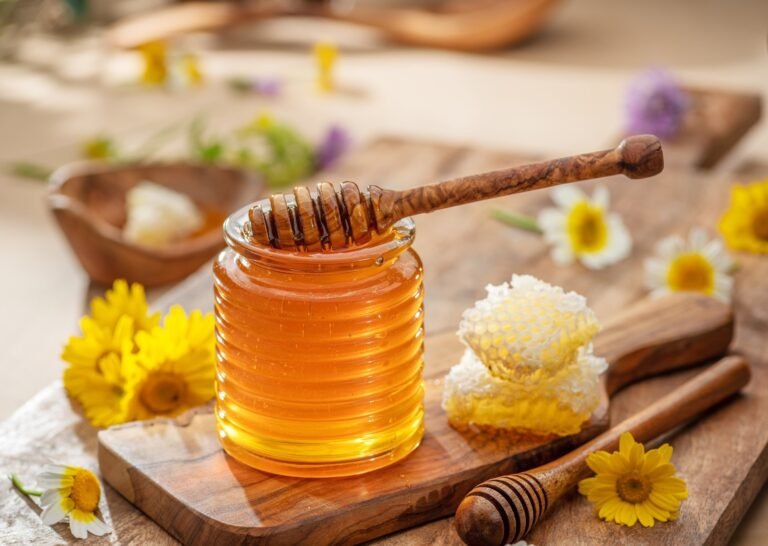Scientists show how Manuka and Ohia Lehua honey differ in their antioxidant potential, showing that while Manuka honey has a higher phenolic content, Ohia Lehua honey excels at reducing oxidative stress and promoting antioxidant defenses.
Study: Phytochemical composition and antioxidant activity of Manuka honey and Ohia Lehua honey. Image credit: Valentyn Volkov / Shuttersotck.com
The use of honey as medicine is widespread in all cultures, mainly due to its antioxidant and anti-inflammatory properties, which protect tissues from oxidative stress. A recent study published in the journal Nutrients investigated the various components of Manuka honey (MH) and ohia lehua honey (OLH) that contribute to their anti-inflammatory properties.
The destructive effects of oxidative stress
Oxidative stress results from an imbalance between reactive oxygen species (ROS) and the body’s antioxidant defenses. During the inflammatory response to injury or infection, immune cells such as macrophages and neutrophils release ROS.
Excess ROS can oxidize and damage cellular proteins, lipids, and nucleic acids, subsequently triggering a cycle of immune inflammatory responses. Unlike acute inflammation, which is the basis of healing, long-term inflammation enhances tissue damage and contributes to chronic disease.
Inflammatory pathways such as nuclear factor kappa B (NF-κB), cyclooxygenase (COX) and mitogen-activated protein kinase (MAPK) lead to the increased production of pro-inflammatory cytokines such as interleukin-6 (IL-6). These cytokines induce inflammation, oxidative stress and the activation of the NLRP3 inflammasome. NLRP3 increases inflammation and can cause chronic inflammatory conditions such as type 2 diabetes and atherosclerosis.
The ingredients of honey
Honey is a natural product consisting mainly of fructose, glucose and water. It also contains many phenolic plant compounds, enzymes and organic acids, as well as hydrogen peroxide (H2THE2) and methylglyoxal (MG), which are both bioactive compounds.
Honey is a traditional medicine used to reduce inflammation and oxidative stress. Its antioxidant properties are essential for the prevention of cardiovascular risk factors, diseases and cancer.
MH is pure honey produced by bees in New Zealand that feed mainly on the Manuka bush (Leptospermum scoparium), while OLH honey is produced in the Ka’u area of the Big Island of Hawaii from bees that feed on Metrosiderospolymorpha flowers.
Both MH honey and Kanuka honey inhibit inflammation in immune and cancer cell cultures. The phenolic acids and flavonoids of honey also have an antioxidant effect.
Previous studies have proven that honey can inhibit bacteria that are resistant to many drugs such as Staphylococcus aureus and Pseudomonas aeruginosa. With its high sugar concentrations, acidic pH and bioactive content, honey prevents microbial growth and wound infection and promotes tissue repair.
Antimicrobial mechanisms in honey are either peroxide or non-peroxide based. Peroxide-based honey converts glucose to gluconic acid and hydrogen peroxide via glucose oxidase. In comparison, peroxide-free honey, such as MH, relies on polyphenols and the formation of methylglyoxal, which suppresses glucose peroxidase activity.
About the study
The current study examined the composition of MH and OLH, particularly the concentrations of polyphenolic plant compounds present in these types of honey. Additional in vitro Experiments were performed to evaluate their antioxidant activity by determining the free radical scavenging capacity of the extracts.
The current study performed several in vitro assays, including ferric ion-reducing antioxidant power (FRAP), 1,1-diphenyl-2-picrylhydrazyl (DPPH), and H2THE2 and nitric oxide (NO) scavenging tests. Trolox, a synthetic analogue of vitamin E, has also been used to measure the antioxidant capacity of foods, beverages and supplements.
In vivo The tests looked at total oxidative stress (TOS), total antioxidant capacity (TAC) and the oxidative stress index (OSI), which reflects the ratio between TOS and TAC in a rat model of inflammation. Levels of advanced protein oxidation products (AOPP), total thiols, malondialdehyde (MDA), which indicates levels of lipid peroxidation, and NO, an endothelial, nerve, and immune-derived signaling molecule, were also measured. in vivo.
Phenolic profile
MH had ten times the phenolic content of OLH. Both honey products contained a wide range of phenolic compounds, with nonflavonoids such as hydroxybenzoic acid accounting for approximately 90% and 68% of phenolics such as 2,4-dihydroxybenzoic acid and gallic acid in MH and OLH, respectively .
Flavonoids include anti-inflammatory and free radical-scavenging apigenin glycoside, quercetin glycoside and quercetin, all of which were present only in MH. Pinocembrin-glucoside was present in both MH and OLH.
Antioxidant properties
OLH was high in vivo antioxidant activity, which is mainly achieved by reducing the oxidative activity of the serum. In addition, OLH reduced TOS, OSI and MDA more than diclofenac, a non-steroidal anti-inflammatory drug (NSAID), in addition to increasing TAC and SH.
OLH prevents lipid peroxidation, reduces oxidative stress, and increases antioxidant capacity rather than inhibiting NO and protein oxidation pathways. At the lower OLH concentration, the antioxidant activity was greater. In contrast, TOS and OSI inhibition was more potent at higher dilutions while exceeding the observed effects of diclofenac.
MH showed limited antioxidant activity at all dilutions compared to its strong antibacterial activity. MH reduced NO and AOPP and increased SH levels, surpassing the effects of diclofenac.
TOS and OSI decreased moderately. Higher dilutions were less effective than diclofenac or Trolox. In particular, the composition and concentration of phenolic compounds in MH is variable, which can change its antioxidant properties.
Syringic acid inhibits pro-inflammatory pathways and scavenges free radicals. MH is high in methyl-syringic acid, which protects DNA from oxidative damage.
conclusions
MH was associated with a tenfold higher phenolic content than OLH, attributed to its antioxidant capacity. However, these effects are concentration dependent. Conversely, OLH significantly reduces oxidative stress by scavenging free radicals and increases serum antioxidant capacity.
Honey is an essential and traditional functional food. Therefore, the components present in honey should be identified and investigated for their possible effect on human health. Such natural foods should be explored as promising sources of dietary antioxidant activity.
Journal Reference:
- Morar, II, Pop, RM, Peitzner, E., et al. (2025). Phytochemical composition and antioxidant activity of Manuka honey and Ohia Lehua honey. Nutrients. doi:10.3390/nu17020276.
